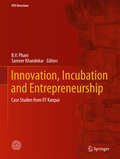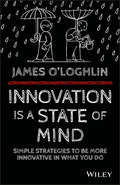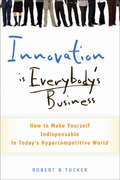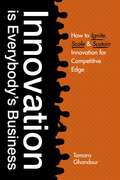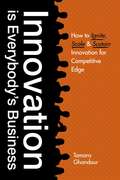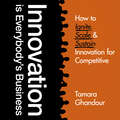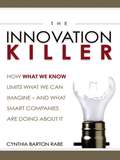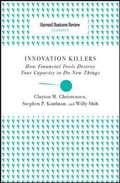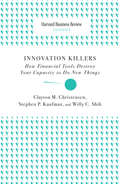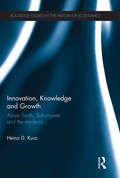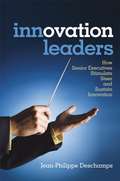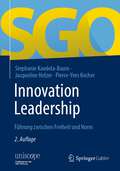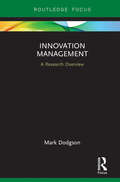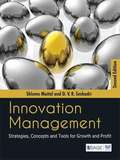- Table View
- List View
Innovation in the U.S. Service Sector (Routledge Studies in Innovation, Organizations and Technology)
by Michael P. Gallaher Albert N. Link Jeffrey E. PetrusaUsing a cutting-edge structure, where a current description of the service sector and up-to-date case studies are compared and contrasted with innovative activity in manufacturing, this book contributes towards a better theoretical understanding of innovation in the U.S. service sector. The U.S. service sector is the largest sector in the U.S. economy and accounts for an increasingly significant share of U.S. gross domestic product, currently 68 percent. Both in the United States, as well as in other industrialized nations, the service sector is a dynamic component of economic activity and growth. As pervasive and economically important as the service sector is, innovative activity in service-sector firms remains somewhat of an enigma; it is not well understood and not well defined because it differs dramatically from the traditional model of innovation in manufacturing. Innovation in the U.S. Service Sector fills this void, placing emphasis on the United States, but with global relevance. It is essential reading for all students of business and management, economics and political science.
Innovation in Urban and Regional Planning: Proceedings of INPUT 2023 - Volume 2 (Lecture Notes in Civil Engineering #463)
by Alessandro Marucci Francesco Zullo Lorena Fiorini Lucia SaganeitiThis book gathers the proceedings of the INPUT2023 Conference on ‘Innovation in Urban and Regional Planning.’ The 12th International Conference INPUT was held at the University of L'Aquila, Italy, on September 6–8, 2023, and brought together international scholars in the fields of planning, civil engineering and architecture, ecology, and social science, to strengthen the knowledge on nature-based solutions and to enhance the implementation and replication of these solutions in different contexts. The book represents the state of the art of modeling and computational approaches to innovations in urban and regional planning, with a transdisciplinary and borderless character to address the complexity of contemporary socio-ecological systems and following a practice-oriented and problem-solving approach. Computational tools, technologies, data, mathematical models, and decision support tools are explored for providing innovative spatial planningmodeling methodologies.
Innovation, Incubation and Entrepreneurship
by Sameer Khandekar B. V. PhaniThis book focuses on promoting entrepreneurial ecosystems within universities and educational institutes. It especially emphasizes the thriving systems and practices existing within the Indian Institute of Technology Kanpur (IITK). It discusses cases and successes of the SIDBI Incubation and Innovation Centre in the Institute. This edited volume highlights the vision of IITK and describes a few of the major achievements of the past few years. It especially showcases the requirements and challenges of creating, sustaining, and boosting such entrepreneurial ecosystems and incubation centres. The contents of this book will be useful to researchers, administrators, and corporate collaborators working in the area of monetizing technology coming from educational institutions by converting it to successful products and business ideas.
Innovation, Innovators and Business: Arab World Edition
by Alexandrina Maria PauceanuThis textbook approaches innovation and innovators as two elements of an equation with business application. It discusses creativity, methods to develop creativity, design thinking, the lean startup and minimum viable product (MVP), personal development for entrepreneurs, charisma, franchising and cases from the UAE. It is designed to be a practical and up-to-date resource for an innovation and entrepreneurship course. It contains practical information about the innovation frameworks and their applicability, explanation of creativity and creative mindset, methods of innovation, design thinking in practice, lean startup methodology, charisma, setting up a business, go-to-market strategies, growth and change as well as franchise management. It comes with worksheets to help the reader in practicing. The book solves the need of having innovation resources in one place, well explained and exemplified for students, aspirant and existing entrepreneurs as well as innovation enthusiasts.
Innovation, Intellectual Property, and Economic Growth
by Christine Greenhalgh Mark RogersWhat drives innovation? How does it contribute to the growth of firms, industries, and economies? And do intellectual property rights help or hurt innovation and growth? Uniquely combining microeconomics, macroeconomics, and theory with empirical analysis drawn from the United States and Europe, this book introduces graduate students and advanced undergraduates to the complex process of innovation. By addressing all the major dimensions of innovation in a single text, Christine Greenhalgh and Mark Rogers are able to show how outcomes at the microlevel feed through to the macro-outcomes that in turn determine personal incomes and job opportunities. In four sections, this textbook comprehensively addresses the nature of innovation and intellectual property, the microeconomics and macroeconomics of innovation, and economic policy at the firm and macroeconomic levels. Among the topics fully explored are the role of intellectual property in creating incentives to innovate; the social returns of innovation; the creation and destruction of jobs by innovation; whether more or fewer intellectual property rights would give firms better incentives to innovate; and the contentious issues surrounding international treaties on intellectual property. Clearly organized and highly readable, the book is designed to be accessible to readers without advanced economics backgrounds. Most technical materials appear in boxed inserts and appendixes, and numerous graphs and tables elucidate abstract concepts. Provides a comprehensive overview of the economic causes and effects of innovation Covers microeconomics, macroeconomics, theoretical and empirical analysis, and policy Includes up-to-date coverage of trends and policy in intellectual property and research and development Features mathematics appendix and keywords and questions to assist learning and teaching Outline lecture slides are available online
Innovation, Intellectual Property, and Economic Growth
by Christine Greenhalgh Mark RogersWhat drives innovation? How does it contribute to the growth of firms, industries, and economies? And do intellectual property rights help or hurt innovation and growth? Uniquely combining microeconomics, macroeconomics, and theory with empirical analysis drawn from the United States and Europe, this book introduces graduate students and advanced undergraduates to the complex process of innovation. By addressing all the major dimensions of innovation in a single text, Christine Greenhalgh and Mark Rogers are able to show how outcomes at the microlevel feed through to the macro-outcomes that in turn determine personal incomes and job opportunities. In four sections, this textbook comprehensively addresses the nature of innovation and intellectual property, the microeconomics and macroeconomics of innovation, and economic policy at the firm and macroeconomic levels. Among the topics fully explored are the role of intellectual property in creating incentives to innovate; the social returns of innovation; the creation and destruction of jobs by innovation; whether more or fewer intellectual property rights would give firms better incentives to innovate; and the contentious issues surrounding international treaties on intellectual property. Clearly organized and highly readable, the book is designed to be accessible to readers without advanced economics backgrounds. Most technical materials appear in boxed inserts and appendixes, and numerous graphs and tables elucidate abstract concepts. Provides a comprehensive overview of the economic causes and effects of innovation Covers microeconomics, macroeconomics, theoretical and empirical analysis, and policy Includes up-to-date coverage of trends and policy in intellectual property and research and development Features mathematics appendix and keywords and questions to assist learning and teaching Outline lecture slides are available online
Innovation Intermediaries: Enabling Open Innovation
by Henry ChesbroughThis chapter discusses the rise of innovation intermediaries, or firms that help companies of many different sizes participate in the emerging secondary markets for innovation and IP and craft more open business models.
Innovation Intermediaries and (Final) Frontiers of High-tech: Supporting the New Space Sector in Scotland
by Matjaz VidmarThis book synthesizes the critical advances in holistic understanding of innovation intermediation. It aims to enable researchers, policy-makers, analysts and practitioners to understand and exploit the best practice in designing and deploying interventions in support of an emergent high-tech geographically-bound sectoral innovation system. The book presents a systematic review of innovation intermediaries’ literature and mixed-methods empirical evidence across a range of projects, building a new comprehensive model of activities and resources deployed.The book highlights the emerging New Space industry in Scotland as a primary case study, but lessons learned can applied to scholarly analysis, policy and operational design of all innovation intermediaries’ interventions, which makes this book essential reading in management, innovation studies, political studies and sociology of technology.
Innovation is a State of Mind
by James O'LoghlinA modern framework for practical innovation--from individual ideas to an innovative organisational culture Everyone says that innovation is important. The problem is that no one tells you how to be innovative. Innovation is a State of Mind sets out a step-by-step guide to creating innovative ideas and putting them into action. You'll learn how to generate more ideas with greater potential, how to grow and evaluate them, test their effectiveness and then implement the ones that are going to improve your business. Author James O'Loghlin has worked with over a thousand of Australia's best inventors and innovators in the eight years he hosted ABC-TV's The New Inventors. He studied what they do differently and how they are able to identify and take advantage of opportunities that the rest of us miss. Packed with engaging stories and a good dose of humour, this insightful guide helps you to make innovation a part of what you do every day. Change your thinking and identify overlooked opportunities Step around common roadblocks to innovation Generate better ideas, and find the ones that will improve your business Create a culture where innovation is part of everyone's job Harvest innovative ideas from the entire staff and find the ones that will make a difference Innovators see things differently. They solve problems that the rest of us can't, and create solutions to problems that we never noticed we had. Getting stuck in routine and procedure is the death knell for modern business. Most companies undervalue and underuse the creative potential of their people, because they underestimate the impact of continuous innovation. Innovation is a State of Mind shows you how to think like an innovator and create a culture of innovation, so you can stay out in front of the future of business.
Innovation is Everybody's Business: How To Make Yourself Indispensable In Today's Hypercompetitive World
by Robert B. TuckerInnovation isn't something you do after you get your work done. It's how you do your work. Organizations all over the world are shedding jobs in record numbers. Yet today, they are desperately in need of people with the abilities and skills to think ahead of the curve, delight customers, motivate colleagues, slash costs, and achieve unconventional results. In this practical road map to becoming irreplaceable, global innovation guru and bestselling author Robert B. Tucker reveals why honing your I-Skills (Innovation Skills) may be the smartest career move you'll make. Based on interviews with forty-three innovation-adept managers and individual contributors, Innovation Is Everybody's Business guides you in: Mastering the seven essential I-Skills you need to become indispensable Unleashing the "mindset, skillset, and toolset of the innovator" that enable you to anticipate and rise to the challenges your organization faces in a hypercompetitive era Developing your Personal Innovation Strategy to address the critical components of becoming irreplaceable Assaulting your assumptions at the personal, organizational, and industry levels Building tools for work-life balance and creating your own job satisfaction If you're ready to stop talking about innovation and start adding value today - in your job, department or organization - you're ready to read and benefit from the powerful message of Innovation is Everybody's Business.
Innovation is Everybody's Business: How to ignite, scale, and sustain innovation for competitive edge
by Tamara GhandourTamara Ghandour, author, podcaster, keynote speaker and founder of innovation training company, LaunchStreet, used to believe that innovation was the domain of a select few, exclusive to certain industries, or relegated to a specific job role. But, as Tamara discovered in her 25 years of work and research, everybody has the capacity to innovate. It's a person's unique innovation style, which can be assessed and channelled, that can transform inertia into innovation.Drawing on eye-opening data from her proprietary Innovation Quotient Edge Assessment, Innovation is Everybody's Business is for those looking for solutions to the daily pain of "how do I prove my worth," a reality for many people whether they work in the C-Suite or on the front-lines. This book will resonate with those that recognize that being more innovative is their ticket to being indispensable. It is also for leaders under pressure to build a culture of innovation but don't know how. As organizations face pressure to innovate, the accountability for making it happen falls on senior and mid-level leaders. They are told what to do, but not how to do it. This book will give them a tool to build a team of innovators who make an impact every day in big and small ways.
Innovation is Everybody¿s Business: How to Ignite, Scale, and Sustain Innovation for Competitive Edge
by Tamara GhandourTamara Ghandour, author, podcaster, keynote speaker and founder of innovation training company, LaunchStreet, used to believe that innovation was the domain of a select few, exclusive to certain industries, or relegated to a specific job role. But, as Tamara discovered in her 25 years of work and research, everybody has the capacity to innovate. It's a person's unique innovation style, (which can be assessed and channelled), that can transform inertia into innovation.Drawing on eye-opening data from her proprietary Innovation Quotient Edge Assessment, Innovation is Everybody's Business is for those looking for solutions to the daily pain of "how do I prove my worth," a reality for many people whether they work in the C-Suite or on the front-lines. This book will resonate with those that recognize that being more innovative is their ticket to being indispensable. It is also for leaders under pressure to build a culture of innovation but don't know how. As organizations face pressure to innovate, the accountability for making it happen falls on senior and mid-level leaders. They are told what to do, but not how to do it. This book will give them a tool to build a team of innovators who make an impact every day in big and small ways.
Innovation is Everybody's Business: How to ignite, scale, and sustain innovation for competitive edge
by Tamara GhandourTamara Ghandour, author, podcaster, keynote speaker and founder of innovation training company, LaunchStreet, used to believe that innovation was the domain of a select few, exclusive to certain industries, or relegated to a specific job role. But, as Tamara discovered in her 25 years of work and research, everybody has the capacity to innovate. It's a person's unique innovation style, which can be assessed and channelled, that can transform inertia into innovation.Drawing on eye-opening data from her proprietary Innovation Quotient Edge Assessment, Innovation is Everybody's Business is for those looking for solutions to the daily pain of "how do I prove my worth," a reality for many people whether they work in the C-Suite or on the front-lines. This book will resonate with those that recognize that being more innovative is their ticket to being indispensable. It is also for leaders under pressure to build a culture of innovation but don't know how. As organizations face pressure to innovate, the accountability for making it happen falls on senior and mid-level leaders. They are told what to do, but not how to do it. This book will give them a tool to build a team of innovators who make an impact every day in big and small ways.(P) 2020 Hodder & Stoughton Ltd
Innovation, Kanoon Aur Garibi: इनोवेशन, कानून और गरीबी
by Robert D. Cooter and Hans-Bernd Schaferकैसे कानून नवाचार (इनोवेशन), विकास, गरीबी पर असर डालते हैं और राष्ट्र गरीब व अमीर बनते हैं। कूटर व शेफर बताते हैं कि इनोवेटर की पूँजी की समस्याओं का हल भी बेहतर कानून कर सकते हैं, जिसे वे विश्वास की दोहरी समस्या कहते हैं तथा इसके समाधान सुझाते हैं। कानून व अर्थशास्त्र के संयुग्मित विचार विश्व की गहनतम समस्याओं के हल की समझ देते हैं। यह पुस्तक राष्ट्रों की गरीबी पर ही नहीं, वरन् उसके नागरिकों की विकास की आकांक्षाओं के लिए कानूनी व इनोवेटिव विचारों को ऊर्जा देती है। भारत में बेहतर कानूनी ढाँचागत व्यवस्था व नवाचार की ऊर्जा है। अतः यह पुस्तक भारतीय पाठकों के लिए उपयोगी सिद्ध होगी।
The Innovation Killer: How What We Know Limits What We Can Imagine -- and What Smart Companies Are Doing About It
by Cynthia Barton RabeKnowledge is good, preaches the inscription under the statue of college founder Emil Faber in the film Animal House. But as valid as that declamation may be at a university, in the corporate world what passes for knowledge can be a killer. Companies and teams rely on what we know and the way we do things here to speed decision making and maintain a sense of order. But progress demands change, risk taking, and occasionally, revolution. Processes must be overhauled, assumptions challenged, taboos broken. But how do you do it? Who among the group will take responsibility for a brand new initiative or unorthodox decision? Who will be willing to stand up and say, in essence, that the emperor has no clothes? As much as we laud the concept of thinking outside of the box, most of us think it's a lot safer to stay inside. It's time to call in a zero-gravity thinker who is not weighed down by the twin innovation killers - GroupThink and its close cousin, ExpertThink. Such outsiders are in plentiful supply, whether from the department down the hall, the branch office, a consulting firm or even another company. Unburdened by all the nagging issues that plague even very effective groups, the outsider will know new ways around a problem, identify possibilities where none seemed to exist, and spot potential problems before they spin out of control. According to The Innovation Killer, the right zero gravity thinker will ideally possess the following traits: Psychological distance: the most important tool of the impartial observer, it enables him or her to maintain an open mind. Renaissance tendencies: a wide rangeof interests, experiences, and influences more readily inspires innovative approaches. Related expertise: strength in a relevant area may lead to intersection points at which solutions are often found. The book helps identify when and why you should call in a collaborator, where to find one, and how you and your team can start working with him or her. There are also strategies for turning yourself into a zero-gravity thinker when it's simply not practical to bring in a true outsider. Knowledge is good, except when it trumps real innovation. Whether your team is too focused on the forest or can't see past the trees, this book will help you add the perspective you need to make the great decisions that will move your company forward.
Innovation Killers: How Financial Tools Destroy Your Capacity To Do New Things
by Clayton M. ChristensenIn this seminal article, innovation experts Clayton Christensen, Stephen P. Kaufman, and Willy C. Shih explore the key reasons why companies struggle to innovate. The authors uncover common mistakes companies make--from focusing on the wrong customers to choosing the wrong products to develop--that can derail innovation efforts, and offer a better way forward for management teams who want to avoid these obstacles and get innovation right.
Innovation Killers: How Financial Tools Destroy Your Capacity to do New Things (Harvard Business Review Classics)
by Clayton M. Christensen Stephen P. Kaufman Willy C. ShihIn this seminal article, innovation experts Clayton Christensen, Stephen P. Kaufman, and Willy C. Shih explore the key reasons why companies struggle to innovate. The authors uncover common mistakes companies make--from focusing on the wrong customers to choosing the wrong products to develop--that can derail innovation efforts, and offer a better way forward for management teams who want to avoid these obstacles and get innovation right.
Innovation, Knowledge and Growth: Adam Smith, Schumpeter and the Moderns (Routledge Studies In The History Of Economics Ser. #104)
by Heinz D. KurzThis book deals with the prime movers of socio-economic development, innovations and technical change, their origins, forms and effects. It contains a set of closely related chapters, some of which have been previously published as papers in scholarly journals
Innovation, Knowledge and Power in Organizations (Routledge Studies in Global Competition)
by Theodora AsimakouThis book examines discourses of knowledge and innovation in post-industrial societies and knowledge-based organizations. The author investigates the value of knowledge and the question of innovation management in a fully commercial environment for a technology company. In contrast with most of the mainstream approaches to knowledge and innovation management this volume chooses as its starting point a critical examination of these assumptions before proceeding with further suggestions on how to manage knowledge. Using brand new empirical research, the author argues for the significance of addressing the political games and power struggles enacted in managing innovation processes, which result from the opportunity certain groups seek to acquire or extend their control over valuable resources. Again, in contrast to mainstream approaches that reduce power to the ability of individuals to negotiate in order to promote their ideas, the analysis adopts an extended view on power, and seeks to reveal the ambiguities and challenges of innovation management. This work will be of most interest to researchers and students of knowledge and innovation management, namely postgraduates and second degree students, as well as managers in knowledge-based organisations.
Innovation Leaders
by Deschamps Jean-PhilippeInnovation leaders promote and address the innovation agenda in their company. Through personal conviction or competitive necessity they are obsessed with providing superior value to customers through innovation. They know how to mobilize their staff behind concrete innovation initiatives and do not hesitate to personally coach innovation teams. For innovation to occur leadership has to be collective. To create a momentum for innovation in their company, leaders from different functions need to team up, to build innovation networks. Innovation leadership is not just an innate talent that can be selected at the hiring level. It can be developed within an appropriate company culture through careful leadership development, typically achieved through career management and coaching. Innovation leaders also need to stay on board and it is the responsibility of the top management team to create an attractive climate to develop and keep its innovation leaders. There are plenty of books that deal with innovation, or with new product development, or with leadership; this is different in its focus on the specifics of innovation leadership - that particular form of leadership that stimulates and sustains innovation. This book maps the broad territory of innovation leadership and contributes new thinking on the focus of the emerging leadership role of the CTO; distinction between 'front end' and 'back end' innovation leaders; the concept of aligning leadership styles with strategy; and the chain of leadership concept. Combining practice-based and empirical research-based observations with simple conceptual frameworks, illustrated by many company examples and case stories from a broad range of industries in the US and Europe, this is a systematic presentation of innovation drivers and their implications in terms of what leaders need to do to make it work.
Innovation Leadership: Innovation Into Action (Leadership Network Innovation Ser. #0)
by David G. Gliddon William J. RothwellA leader's ability to discover and implement innovations is crucial to adapting to changing technologies and customer preferences, enhancing employee creativity, developing new products, supporting market competitiveness, and sustaining economic growth. Gliddon and Rothwell provide an exciting and comprehensive resource for readers that are currently seeking to build success in organizations with new ideas. Innovation leadership involves synthesizing different leadership styles in organizations to influence employees to produce creative ideas, products, services, and solutions. It is a practice and an approach to organization development and organizational change. Innovation leadership commonly includes four basic stages, which are: (a) support for idea generation, (b) identifying innovations, (c) evaluating innovations, and (d) implementation. There are two types of innovations, including: (a) exploratory innovation, which involves generating brand new ideas, and (b) value-added innovation, which involves modifying and renewing ideas that already exist. The two fundamental leadership theories that are generally necessary for innovation leadership are path-goal theory and Leader Member Exchange theory. The key role in the practice of innovation leadership is that of the innovation leader. However, there are currently multiple perspectives on the definition of an innovation leader. An individual in an organization, a group within an organization, the organization itself, and even a community, state, or nation can be considered an innovation leader. The book explores each of these perspectives on the definition of an innovation leader.
Innovation Leadership: Führung zwischen Freiheit und Norm (uniscope. Publikationen der SGO Stiftung)
by Stephanie Kaudela-Baum Jacqueline Holzer Pierre-Yves KocherWir befinden uns mitten in einer modernen industriellen Revolution, in der Innovation eine entscheidende Rolle für den Unternehmenserfolg spielt und innovationsfördernde Führung wichtiger ist denn je. Immer mehr Unternehmen integrieren Technologien wie künstliche Intelligenz, Machine Learning und Data Science in ihre Prozesse und es gilt, Mitarbeitende zu entwickeln und neu zu rekrutieren, die diese Technologien beherrschen. In diesem Buch erfahren die Leserinnen und Leser anhand zahlreicher Beispiele, wie der Drahtseilakt zwischen einer stetigen Weiterentwicklung des Kerngeschäfts und der Etablierung neuer Wege und Denkweisen durch Kreativität gelingt. Eine Fähigkeit, die gerade im Zeitalter der Digitalisierung an Bedeutung gewinnt. Die Autorinnen und der Autor richten den Fokus auf die Beziehungsgestaltung zwischen Führenden und Geführten zur Förderung der Innovationsfähigkeit und entwickeln ein Innovation- Leadership-Modell (kurz: InnoLEAD). Dieses Modell unterstützt Führungspersonen dabei, sich im Spannungsfeld zwischen Exploitation und Exploration zu orientieren und ihre eigene Rolle zu reflektieren. Zudem werden strategische, strukturelle und kulturelle Dimensionen der Organisations- und Personalentwicklung aufgegriffen. Zahlreiche Praxisbeispiele illustrieren das Modell. Für die 2. Auflage wurden neue Fallbeispiele integriert und aktuelle Theorien, Konzepte und Forschungsergebnisse aufgenommen.
Innovation leben!: Wie Sie in Ihrem Unternehmen Zukunftspotenziale erkennen, beurteilen und heben
by Lena LuhrmannInnovation ist ein Wettlauf gegen Mitbewerber und gegen die große überall lauernde Unbekannte, die Überflüssigwerdung. Der Druck im Nacken, auch zu denen an der Spitze zu gehören, die schlaflosen Nächte, wenn man merkt, dass das Innovationsbestreben wieder mal vertagt worden ist, weil es, oberflächlich betrachtet, nicht drängt. Die Angst, dass man eines Morgens aufwacht, der Markt gekippt ist und man von heute auf morgen von einem 10 Personen Start-up aus einer Garage in Wanne Eickel überholt worden ist. Dieses Buch hilft, aus einer anderen Perspektive auf das Thema Innovation zu blicken - und zwar auf allen Hierachieebenen und aus Sicht verschiedener Bereiche, in denen Innovationen eine Rolle spielen. Es beleuchtet, woran Innovation immer noch und immer wieder scheitert, obwohl alle notwendigen Techniken und Budgets aufgefahren wurden. Lena Lührmann zeigt, was auf Bauch- und Kopfebene, zwischenmenschlich und haptisch passiert, wenn Menschen an Innovation denken oder sich damit befassen. Sie möchte so das Bewusstsein bei Führungskräften und Entscheidern in Unternehmen dafür wecken, was ihre Mitarbeiter in Sachen Innovation leisten oder auch nicht. Nur wenn die Leser sich selbst und ihr Unternehmen in dieser Hinsicht verstehen, werden sie in der Lage sein, aus allen wirklich großartigen Techniken die für sie passende herauszufinden. Anhand vieler "Aha-Momente" werden sie die im Buch beschriebenen Problematiken aus der Praxis in ihrem eigenen Unternehmen identifizieren und angehen können. Ziel soll sein: - Innovationsfähigkeitslevel beurteilen, - Innovationchancen erkennen, - Innovation mitmachen, - Innovation beurteilen, - Innovation leben, ganz natürlich aus dem Selbstverständnis des Unternehmens heraus. Jedes Kapitel umfasst drei Aspekte, um sich dem Thema zu nähern: Key Aussagen, Fakten und Lösungen, persönliche Erlebnisse der Autorin.
Innovation Management: A Research Overview (State of the Art in Business Research)
by Mark DodgsonInnovation is the means by which organizations survive and thrive in uncertain and turbulent conditions. Innovation management has become a well-established field of research, teaching and practice, with a substantial literature. As a broad-based research field, contributions stem from an array of perspectives including science, economics, engineering and psychology. Innovation is crucial for economic and social progress, and it needs to be managed in order to be beneficial. Innovation Management: A Research Overview provides a concise introduction to the best research on innovation management. It covers four main themes: foundational studies, key concepts and frameworks, important empirical studies, and current and emerging themes. The research discussed includes classic studies, with core insights in the field, key thinking on strategies and processes for innovation, well-established and novel research methods, and issues of greatest contemporary importance. This shortform book provides direction through the maze of research on the nature, processes and outcomes of innovation management, and provides an invaluable introduction to the literature on innovation management for students and professionals.
Innovation Management
by Professor Shlomo Maital D V SeshadriInnovation Management: Strategies, Concepts and Tools for Growth and Profit is a unique book in the rapidly growing discipline of Innovation Management. It seeks to build on the experience from an earlier discipline--Competitive Strategy. It took more than two decades for practitioners to realize that successful strategy is driven by implementation, not by formulation. Similarly, successful innovation--the key to growth and profit--rests on disciplined management and implementation of the innovation process from start to finish. This book first answers the key questions: Why innovate? How to innovate? Who innovates? It then provides 10 essential and practical tools to help innovators guide their ideas to marketplace success. Following the publication of the successful first edition, and in response to many readers' positive feedback for its case studies, the second edition contains a large number of new mini case studies about innovative start-ups, businesses, and ideas in the period of 2007-12 Innovation Management shows how companies and individuals can transform creative ideas into powerful, sustainable, change-the-world businesses and emphasizes the crucial role of execution in implementing inspiring ideas.


